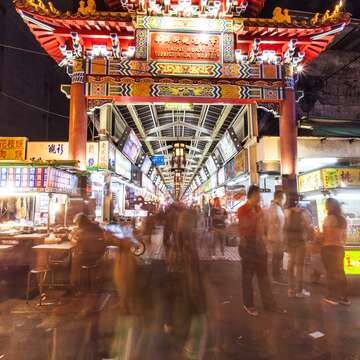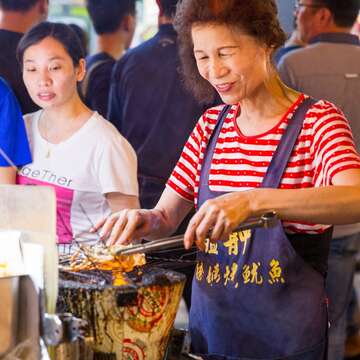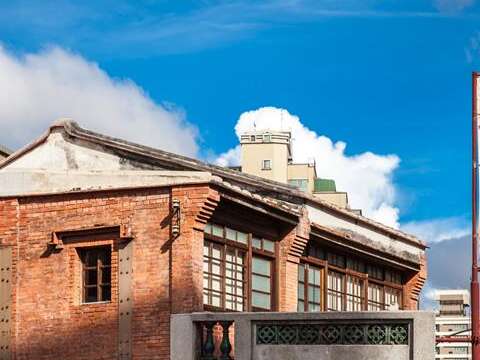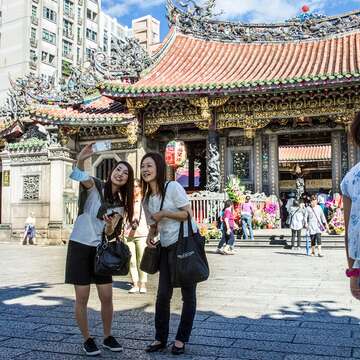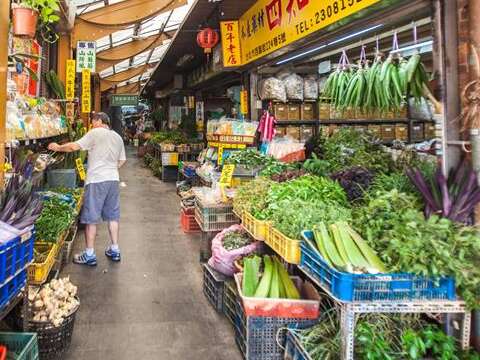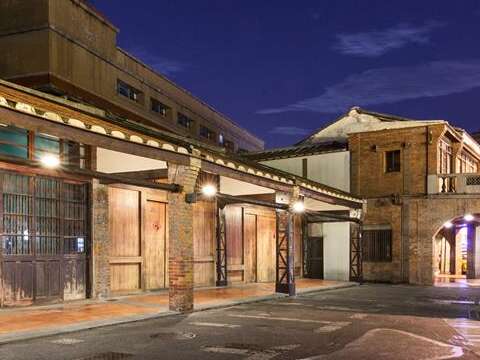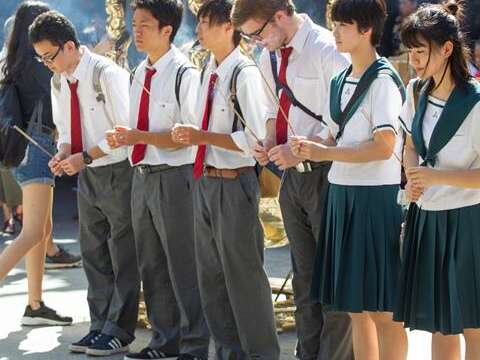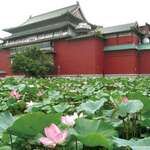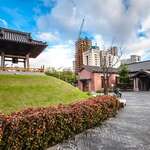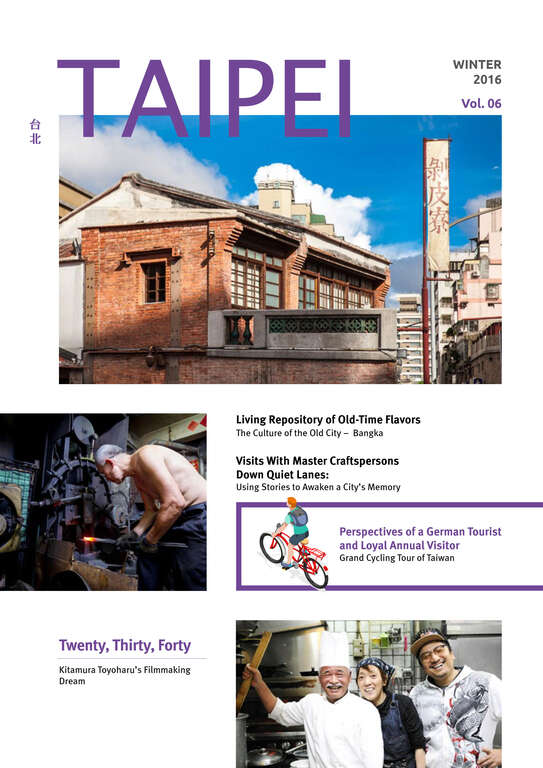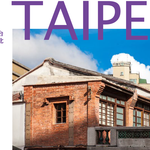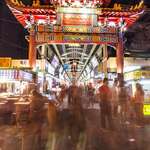Post date:2017-03-10
1590
Living Repository of Old-Time Flavors
The Culture of the Old City – Bangka
Article_Xu Ciqian
Photos_Shi Chuntai
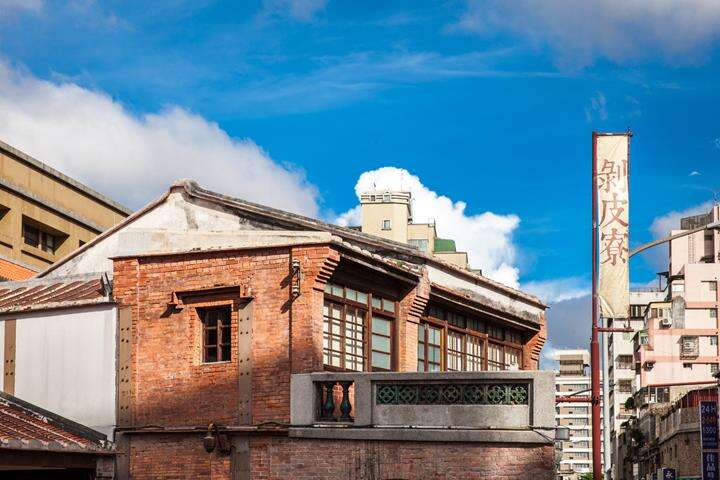
▲ Under the pen of Akira Higashiyama, the old railway of yesteryear seems to reappear right before your eyes. (Photo: Shi Chuntai)
The old name for the district of Wanhua, still used by many locals, is Bangka (艋舺). In an earlier time, it was one of Taiwan’s three major urban centers. In turn, its prosperity drove the development of the transportation infrastructure. Recalling the days of his youth living on Guangzhou Street, author Akira Higashiyama remembers the north-south railway running parallel to Zhonghua Road (中華路), and how it divided Guangzhou Street, one side home to many new immigrants who had followed the Nationalist government from mainland China to Taiwan, the other home to those whose ancestors had come from China in imperial times. The railway partitioned what were, in effect, two different peoples, creating two enclaves busy with distinct languages and living customs of different ethnic groups. In Ryu, Akira reimagines his childhood days crossing the Guangzhou Street tracks, heading west toward Lungshan Temple (龍山寺) and today’s Bopiliao Historic Block (剝皮寮歷史街區), and the curiosity and fear that children oft felt seeing the big world beyond their doorstep. The novel’s Wanhua has an air of chilling ruthlessness. He also uses classic Huaxi Street (華西街) scenes of snakes being killed and gutted to emphasize the strikingly different perspectives of the common people.
Though the disappearance of the beloved China Plaza causes people great regret, the atmosphere that prevails among the everyday folk of Wanhua is like the call of their distant hometowns. As long as you are willing to go to her, the sights and sounds experienced by the children of today are in truth not distant from those experienced by their ancestors. The red-brick architecture of Bopiliao, the swirling incense-smoke curls of Lungshan Temple, the endless streams of sightseers along Huaxi Street, and the heady fragrances of fresh herbs and herbal medicines on Herb Alley (青草巷) all remain. The sight of locals traipsing along streets and alleys in tank tops and flip-flops, and the many, many long-in-place eateries serving up delicious foods and snack delicacies, for Akira, who has lived in Japan for many years, these are all elements in the cultural pageantry he holds so dear. The vignettes, changing yet not changing, forming a timeless unfolding Taipei scroll painting.
Lungshan Temple & Herb Alley – The Sustenance of Life
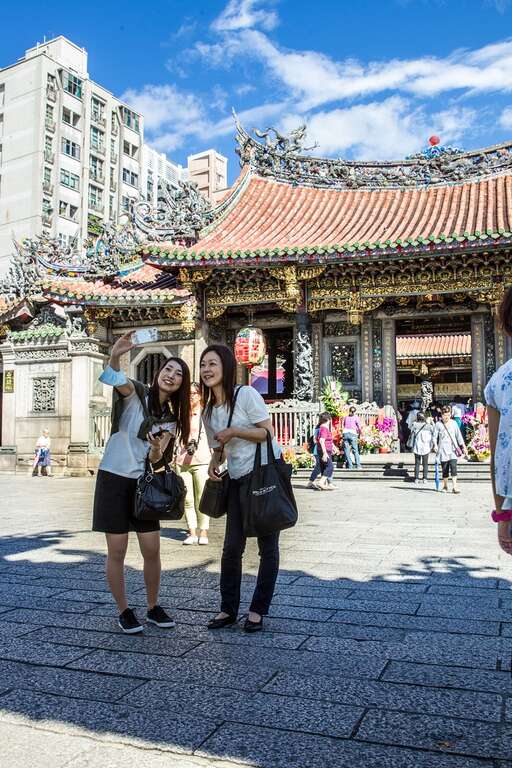
▲ The over 200-year-old Lungshan Temple is Wanhua’s key local center of worship and a must-visit attraction for tourists. (Photo: Shi Chuntai)
In such a scroll painting, invariably the most distinctive local structure is the Lungshan Temple. The imposing temple, now over 200 years old, is a key center of worship. Adding to the religious element is the stunning architecture and the mythical tales surrounding the complex, which people find fascinating. There is a steady parade of celebrations and ceremonies throughout the year, and if you want a look at the continued power of folk belief in local people’s lives, this is a fine place to start. Beyond the fact that this Class II National Monument has been part of this community for hundreds of years, another key to its far-flung renown are the many vendors of delicious snack foods around it, which foodies find irresistible. “Two Happinesses” Thick Squid Soup (兩喜號魷魚羹), Zhou’s Meat Congee (周記肉粥), and Longdu Ice Dessert Parlor (龍都冰菓專業家) are all great spots to sample authentic local flavors.
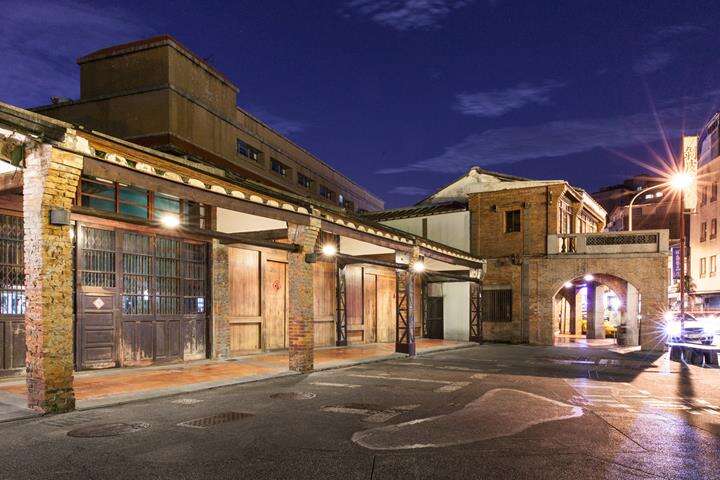
▲ For Akira Higashiyama, the ambience among the everyday folk of Wanhua is like the call of one’s hometown. (Photo: Shi Chuntai)
Right beside Lungshan Temple is Lane 224, Xichang Street (西昌街). This pedestrian-narrow lane, less than 50 meters long, is known all over Taiwan as Herb Alley. After the heady fragrance of the temple’s wafting curls of incense smoke, the aromas of the medicinal herbs are refreshing. With temple and alley adjacent, starting about 40 or 50 years ago, when local residents would not feel well they would go to the temple to ask the gods for guidance, then come to the alley to buy the suggested medicinal herbs. However, in the 1980s, the government implemented medical regulations that prohibited the temple from issuing medicinal divination slips, bringing the practice of deities “treating” illness to an end.
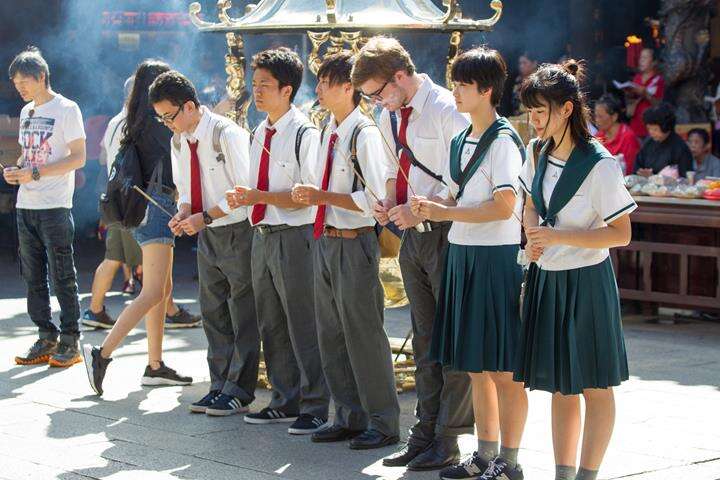
▲ If interested in a window into the dynamism of local folk religion, time at Lungshan Temple is recommended. (Photo: Shi Chuntai)
Today, nevertheless, Herb Alley possesses even more charm than in the past, with many pleasant little surprises awaiting the tourist. The facilities here are comprehensive and have been well planned out: the transparent covering over the lane allows natural light to stream in, and the ventilation and cool shade provided are beneficial for medicinal herb preservation. The result is a little tucked-away city corner of elegance and elegant fragrances that city residents enjoy coming to linger in – an attractive sightseeing spot for travelers. It has even become a popular “living classroom,” where students learn about traditional local culture. While browsing, buy a cup of the herbal tea, thirst-quenching and a traditional way to disperse heat. Each sip brims with the wisdom of Taiwan’s cultural ancestors, and even international visitors interested in Chinese medicine come, seeking to learn more about the use of fresh, medicinal herbs.
Guangzhou Street & Huaxi Street – Cooking Up Food Nostalgia
Guangzhou Street is almost surely the thoroughfare mentioned most often in Ryu. The protagonist lived here, Chinese mainlanders clustered here, the sounds of different accents and languages flowed back and forth, and chickens and dogs roamed between the houses. Kids from the same age groups formed gangs and alliances or else became strangers to each other. The injury and pain experienced in the process of growing up were the mark or badge of the era. The fact that one was bullied was never something to keep secret, nor a source of embarrassment.
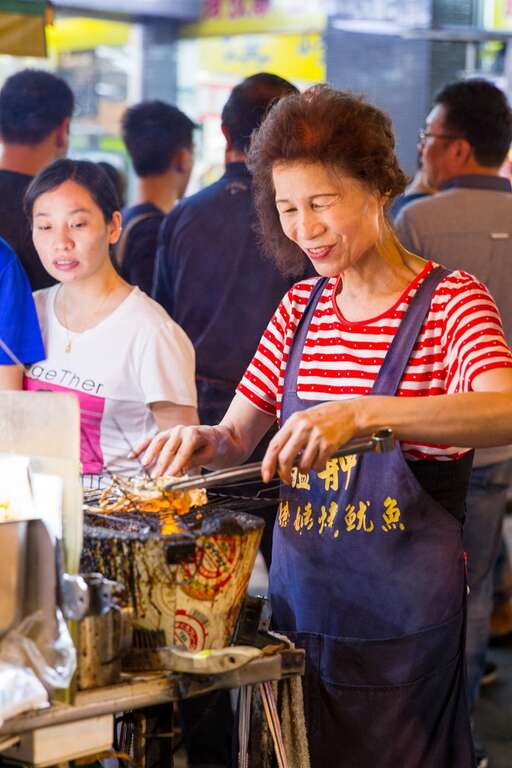
▲ Bangka serves up an almost endless array of must-try traditional Taiwan snack treats. (Photo: Shi Chuntai)
The scenes from a simpler day portrayed in Ryu no longer inhabit Guangzhou Street. Occasionally, the cry of a tofu pudding (豆花) hawker is heard, and people listen to his tales of his life experiences in a busy residential area. Today’s Guangzhou Street becomes very lively, with night-market vendors packed tightly together in a veritable paradise of traditional Taiwanese snack delicacies. Add to this the many game booths set up and you have a recipe for fun, perfect for outings by groups of friends and families – and perfect for experiencing the everyday culture of ordinary Taiwan folk.
In Taipei’s old city neighborhoods, the charms are myriad and the nostalgia-inducing food and drink nigh endless. The home-style offerings on Guangzhou Street and the ostentatious exuberance on Huaxi Street each have their following. Huaxi Street between Guilin Road (桂林路) and Guangzhou Street was Taiwan’s first tourist night market. Its entrance arch is dramatically eye-catching, and colorful red lanterns hang in rows down both sides of the narrow pedestrian-only street.As night falls they are lit up to welcome the ever-growing surge of fun-seekers, creating the bustling, festive scenes that make this a must-see destination for travelers. In days past, the “snake shows” brought many sightseers, but today the horde of snake shops is a thing of the past. One shop still in place, eclectically called the Asia Poisonous Snake Research Institute (亞洲毒蛇研究所), is in fact one of the old-style small snake eateries. The menu is wide-ranging, testing the courage of tourists. Other must-try culinary options include bowl rice cakes (碗粿), chilled Aiyu jelly (愛玉冰), and Dan Zai noodles (擔仔麵).
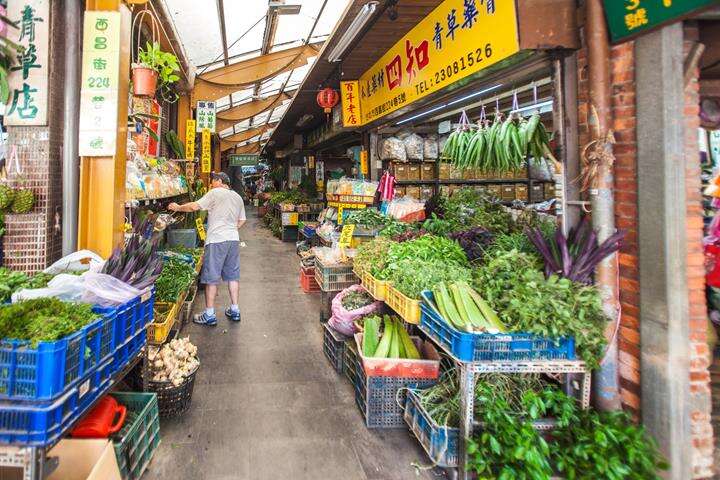
▲ Right beside Lungshan Temple is Lane 224, Xichang Street, the renowned Herb Alley, which is less than 50 meters long. (Photo: Shi Chuntai)
Asia’s night markets are among the prime attractions for visiting international tourists. The traditional Taiwanese culinary fare found in Wanhua can justifiably be placed among the leaders. When traveling through, whatever you do, do not simply pass by without stopping!
Retro & New – The Evolution of Culture
The area bounded by Guangzhou Street, Kangding Road (康定路), and Kunming Street (昆明街) is today called the Bopiliao Historic Block. From the Qing Dynasty, Bopiliao was a hub for key arteries leading between Wanhua and other settlements. The Qing Dynasty streetscape has been preserved in this popular tourist attraction, and the hit 2010 Taiwanese gangster film Monga (艋舺) generated a lasting surge in interest. Local and international tourists come to immerse themselves in the quiet ambience of bygone days, savoring the architecture and cultural relics. In addition, in recent years more and more artists and artisans from Taiwan and abroad have come to create exhibits and new works, pouring artistic and cultural energy into Bopiliao.
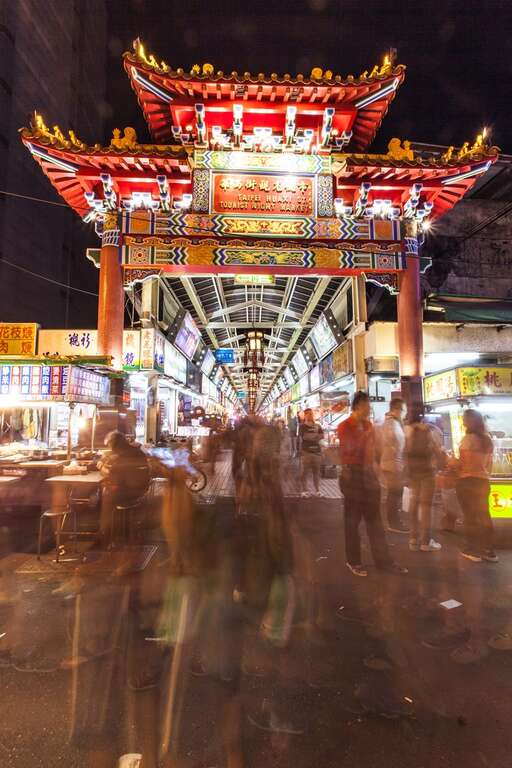
▲ Huaxi Street Tourist Night Market’s striking entrance arch and the excitement of the steady crowds attracts many international sightseers. (Photo: Shi Chuntai)
Yet, though with deep currents of nostalgia running through it, Wanhua is much, much more. Ladies with a focus on personal beauty must visit Dali Street (大理街). In its heyday the Bangka Clothing District (艋舺服飾商圈) was home to more than 1,000 apparel outlets. Beyond the sale of finished apparel, enterprises are engaged in design, pattern and sample making, production, and marketing. All through the chain, competitive prices and quality are offered. In days past, many consumers headed to Dadaocheng’s Dihua Street (迪化街) to buy fabrics, then asked the shops to custom-tailor clothing. Today, ready-to-wear clothing is the norm, and Dali Street’s comprehensive range of women’s and children’s attire has made it a “fashion password” for female shoppers.
The Culture of the Old City – Bangka
Article_Xu Ciqian
Photos_Shi Chuntai

▲ Under the pen of Akira Higashiyama, the old railway of yesteryear seems to reappear right before your eyes. (Photo: Shi Chuntai)
The old name for the district of Wanhua, still used by many locals, is Bangka (艋舺). In an earlier time, it was one of Taiwan’s three major urban centers. In turn, its prosperity drove the development of the transportation infrastructure. Recalling the days of his youth living on Guangzhou Street, author Akira Higashiyama remembers the north-south railway running parallel to Zhonghua Road (中華路), and how it divided Guangzhou Street, one side home to many new immigrants who had followed the Nationalist government from mainland China to Taiwan, the other home to those whose ancestors had come from China in imperial times. The railway partitioned what were, in effect, two different peoples, creating two enclaves busy with distinct languages and living customs of different ethnic groups. In Ryu, Akira reimagines his childhood days crossing the Guangzhou Street tracks, heading west toward Lungshan Temple (龍山寺) and today’s Bopiliao Historic Block (剝皮寮歷史街區), and the curiosity and fear that children oft felt seeing the big world beyond their doorstep. The novel’s Wanhua has an air of chilling ruthlessness. He also uses classic Huaxi Street (華西街) scenes of snakes being killed and gutted to emphasize the strikingly different perspectives of the common people.
Though the disappearance of the beloved China Plaza causes people great regret, the atmosphere that prevails among the everyday folk of Wanhua is like the call of their distant hometowns. As long as you are willing to go to her, the sights and sounds experienced by the children of today are in truth not distant from those experienced by their ancestors. The red-brick architecture of Bopiliao, the swirling incense-smoke curls of Lungshan Temple, the endless streams of sightseers along Huaxi Street, and the heady fragrances of fresh herbs and herbal medicines on Herb Alley (青草巷) all remain. The sight of locals traipsing along streets and alleys in tank tops and flip-flops, and the many, many long-in-place eateries serving up delicious foods and snack delicacies, for Akira, who has lived in Japan for many years, these are all elements in the cultural pageantry he holds so dear. The vignettes, changing yet not changing, forming a timeless unfolding Taipei scroll painting.
Lungshan Temple & Herb Alley – The Sustenance of Life

▲ The over 200-year-old Lungshan Temple is Wanhua’s key local center of worship and a must-visit attraction for tourists. (Photo: Shi Chuntai)
In such a scroll painting, invariably the most distinctive local structure is the Lungshan Temple. The imposing temple, now over 200 years old, is a key center of worship. Adding to the religious element is the stunning architecture and the mythical tales surrounding the complex, which people find fascinating. There is a steady parade of celebrations and ceremonies throughout the year, and if you want a look at the continued power of folk belief in local people’s lives, this is a fine place to start. Beyond the fact that this Class II National Monument has been part of this community for hundreds of years, another key to its far-flung renown are the many vendors of delicious snack foods around it, which foodies find irresistible. “Two Happinesses” Thick Squid Soup (兩喜號魷魚羹), Zhou’s Meat Congee (周記肉粥), and Longdu Ice Dessert Parlor (龍都冰菓專業家) are all great spots to sample authentic local flavors.

▲ For Akira Higashiyama, the ambience among the everyday folk of Wanhua is like the call of one’s hometown. (Photo: Shi Chuntai)
Right beside Lungshan Temple is Lane 224, Xichang Street (西昌街). This pedestrian-narrow lane, less than 50 meters long, is known all over Taiwan as Herb Alley. After the heady fragrance of the temple’s wafting curls of incense smoke, the aromas of the medicinal herbs are refreshing. With temple and alley adjacent, starting about 40 or 50 years ago, when local residents would not feel well they would go to the temple to ask the gods for guidance, then come to the alley to buy the suggested medicinal herbs. However, in the 1980s, the government implemented medical regulations that prohibited the temple from issuing medicinal divination slips, bringing the practice of deities “treating” illness to an end.

▲ If interested in a window into the dynamism of local folk religion, time at Lungshan Temple is recommended. (Photo: Shi Chuntai)
Today, nevertheless, Herb Alley possesses even more charm than in the past, with many pleasant little surprises awaiting the tourist. The facilities here are comprehensive and have been well planned out: the transparent covering over the lane allows natural light to stream in, and the ventilation and cool shade provided are beneficial for medicinal herb preservation. The result is a little tucked-away city corner of elegance and elegant fragrances that city residents enjoy coming to linger in – an attractive sightseeing spot for travelers. It has even become a popular “living classroom,” where students learn about traditional local culture. While browsing, buy a cup of the herbal tea, thirst-quenching and a traditional way to disperse heat. Each sip brims with the wisdom of Taiwan’s cultural ancestors, and even international visitors interested in Chinese medicine come, seeking to learn more about the use of fresh, medicinal herbs.
Guangzhou Street & Huaxi Street – Cooking Up Food Nostalgia
Guangzhou Street is almost surely the thoroughfare mentioned most often in Ryu. The protagonist lived here, Chinese mainlanders clustered here, the sounds of different accents and languages flowed back and forth, and chickens and dogs roamed between the houses. Kids from the same age groups formed gangs and alliances or else became strangers to each other. The injury and pain experienced in the process of growing up were the mark or badge of the era. The fact that one was bullied was never something to keep secret, nor a source of embarrassment.

▲ Bangka serves up an almost endless array of must-try traditional Taiwan snack treats. (Photo: Shi Chuntai)
The scenes from a simpler day portrayed in Ryu no longer inhabit Guangzhou Street. Occasionally, the cry of a tofu pudding (豆花) hawker is heard, and people listen to his tales of his life experiences in a busy residential area. Today’s Guangzhou Street becomes very lively, with night-market vendors packed tightly together in a veritable paradise of traditional Taiwanese snack delicacies. Add to this the many game booths set up and you have a recipe for fun, perfect for outings by groups of friends and families – and perfect for experiencing the everyday culture of ordinary Taiwan folk.
In Taipei’s old city neighborhoods, the charms are myriad and the nostalgia-inducing food and drink nigh endless. The home-style offerings on Guangzhou Street and the ostentatious exuberance on Huaxi Street each have their following. Huaxi Street between Guilin Road (桂林路) and Guangzhou Street was Taiwan’s first tourist night market. Its entrance arch is dramatically eye-catching, and colorful red lanterns hang in rows down both sides of the narrow pedestrian-only street.As night falls they are lit up to welcome the ever-growing surge of fun-seekers, creating the bustling, festive scenes that make this a must-see destination for travelers. In days past, the “snake shows” brought many sightseers, but today the horde of snake shops is a thing of the past. One shop still in place, eclectically called the Asia Poisonous Snake Research Institute (亞洲毒蛇研究所), is in fact one of the old-style small snake eateries. The menu is wide-ranging, testing the courage of tourists. Other must-try culinary options include bowl rice cakes (碗粿), chilled Aiyu jelly (愛玉冰), and Dan Zai noodles (擔仔麵).

▲ Right beside Lungshan Temple is Lane 224, Xichang Street, the renowned Herb Alley, which is less than 50 meters long. (Photo: Shi Chuntai)
Asia’s night markets are among the prime attractions for visiting international tourists. The traditional Taiwanese culinary fare found in Wanhua can justifiably be placed among the leaders. When traveling through, whatever you do, do not simply pass by without stopping!
Retro & New – The Evolution of Culture
The area bounded by Guangzhou Street, Kangding Road (康定路), and Kunming Street (昆明街) is today called the Bopiliao Historic Block. From the Qing Dynasty, Bopiliao was a hub for key arteries leading between Wanhua and other settlements. The Qing Dynasty streetscape has been preserved in this popular tourist attraction, and the hit 2010 Taiwanese gangster film Monga (艋舺) generated a lasting surge in interest. Local and international tourists come to immerse themselves in the quiet ambience of bygone days, savoring the architecture and cultural relics. In addition, in recent years more and more artists and artisans from Taiwan and abroad have come to create exhibits and new works, pouring artistic and cultural energy into Bopiliao.

▲ Huaxi Street Tourist Night Market’s striking entrance arch and the excitement of the steady crowds attracts many international sightseers. (Photo: Shi Chuntai)
Yet, though with deep currents of nostalgia running through it, Wanhua is much, much more. Ladies with a focus on personal beauty must visit Dali Street (大理街). In its heyday the Bangka Clothing District (艋舺服飾商圈) was home to more than 1,000 apparel outlets. Beyond the sale of finished apparel, enterprises are engaged in design, pattern and sample making, production, and marketing. All through the chain, competitive prices and quality are offered. In days past, many consumers headed to Dadaocheng’s Dihua Street (迪化街) to buy fabrics, then asked the shops to custom-tailor clothing. Today, ready-to-wear clothing is the norm, and Dali Street’s comprehensive range of women’s and children’s attire has made it a “fashion password” for female shoppers.
Gallery
:::
Popular articles
 TAIPEI QUARTERLY 2016 WINTER Vol.06
TAIPEI QUARTERLY 2016 WINTER Vol.06 Women’s Volleyball Super-Spiker Wang Sin-Ting (TAIPEI QUARTERLY 2016 WINTER Vol.06)
Women’s Volleyball Super-Spiker Wang Sin-Ting (TAIPEI QUARTERLY 2016 WINTER Vol.06) Paiwan Skating ‘God of War’ Sung Ching-Yang (TAIPEI QUARTERLY 2016 WINTER Vol.06)
Paiwan Skating ‘God of War’ Sung Ching-Yang (TAIPEI QUARTERLY 2016 WINTER Vol.06) A literary World Flow Tour of Taipei-A Look at the Old City’s Elegance (TAIPEI QUARTERLY 2016 WINTER Vol.06)
A literary World Flow Tour of Taipei-A Look at the Old City’s Elegance (TAIPEI QUARTERLY 2016 WINTER Vol.06) The Culture of the Old City – Bangka (TAIPEI QUARTERLY 2016 WINTER Vol.06)
The Culture of the Old City – Bangka (TAIPEI QUARTERLY 2016 WINTER Vol.06) The Rise of Post-Youth Culture and Creativity Arts Pilgrimage – Ximending (TAIPEI QUARTERLY 2016 WINTER Vol.06)
The Rise of Post-Youth Culture and Creativity Arts Pilgrimage – Ximending (TAIPEI QUARTERLY 2016 WINTER Vol.06)
 The Culture of the Old City – Bangka (TAIPEI QUARTERLY 2016 WINTER Vol.06)
The Culture of the Old City – Bangka (TAIPEI QUARTERLY 2016 WINTER Vol.06)